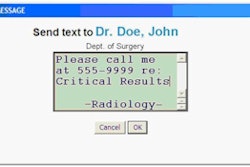LAS VEGAS - Communication of critical radiology results is a vital issue, but there isn't a magic bullet that can prevent all communication errors, according to a presentation Thursday at the Healthcare Information and Management Systems Society (HIMSS) meeting.
Since every practice and every scenario are different, a hybrid approach involving various communication methods can be used, said Dr. Jonathan Berlin of NorthShore University HealthSystem. Whether the communication is made via the electronic medical record (EMR), email, fax, or phone, it doesn't matter as long as the communication is conveyed.
"The most important thing is to have an awareness of the problem so that we can address the problem," he said. "Communications tend to evolve over time."
In critical results reporting, the first step is one-way communication, such as calling, sending an email, and sending a fax, and "ensuring that the report was received," Berlin said. "And of course that needs to be documented."
Many healthcare providers and entities use an EMR system, and some of these systems have email programs to assist in communication, he said. An email receipt can document communication, for example.
"Communication is facilitated with an EMR, but it's not necessarily enough," he said.
Commercial products also are available to assist in this task, and options may include email or text messaging, according to Berlin. Ordering physicians can often specify which mode of communication they prefer, and these tools can be integrated into the EMR.
Electronic communication issues
For all its benefits, electronic communication also has issues to be aware of, including physician demographics. By 2020, half of U.S. physicians will be 65 or older by 2020, and many physicians in this demographic may not be as comfortable with some electronic communication methods, Berlin said.
"We have to be cognizant of the fact that in different demographics, different people prefer different communication [methods]," he said.
In addition, subtleties are often not conveyed during electronic communication, Berlin noted. It also does not facilitate confirmation of the understanding of the conveyed information.
"Electronic communication, while it's very important, there also has to be some element to supplement different kinds of communication and voice communication," he said.
Closed-loop communication, which attempts to address the problem of incomplete understanding of conveyed information by having respondents "read back" what they think they heard to confirm understanding, would seem to be an ideal method. However, this technique can be difficult to use as medical decision-making can have many subtleties and nuances, Berlin said.
"Sometimes it doesn't fit, but it's certainly something that we have to try to achieve," he said.
In fact, the Joint Commission's No. 2 goal in improving communication recommends that critical test results be read back to the person who first delivered the test results.
Communication approaches evolve over time, and new methods may potentially facilitate handling critical results communication, Berlin noted.




















